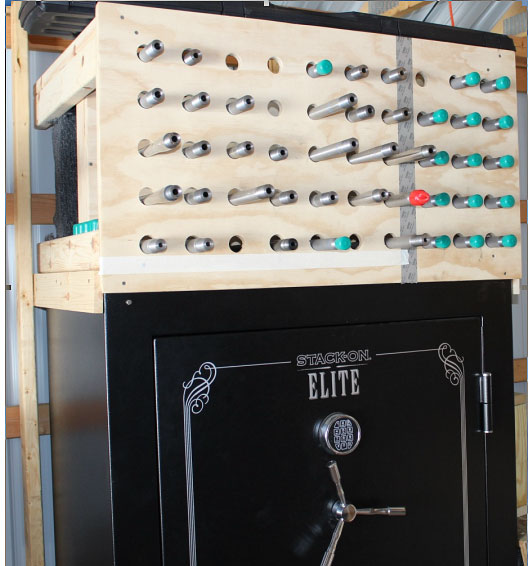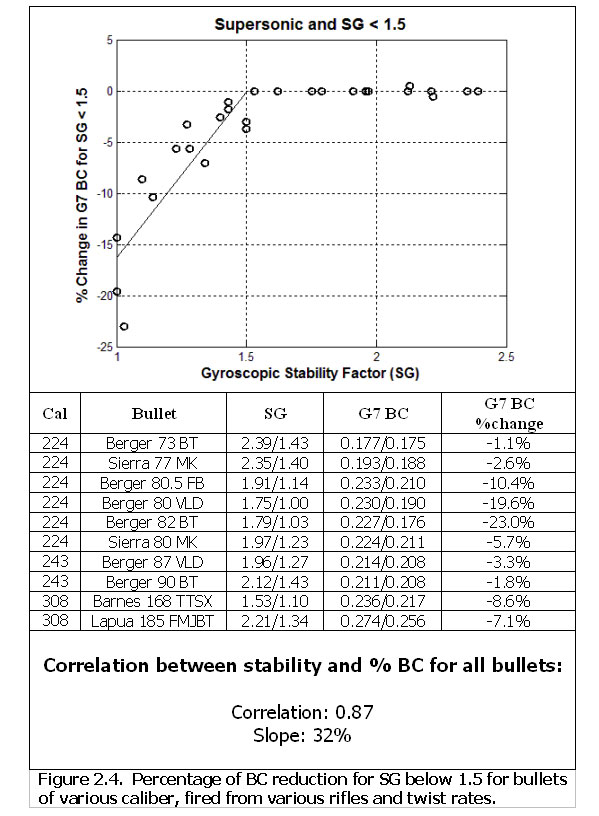How Ballistic Coefficent Varies with Twist Rate (Stabilization)
By Bryan Litz, Applied Ballistics
 Last month, in the Daily Bulletin, we talked about twist rate and muzzle velocity. That discussion was based on a detailed study published in Modern Advancements in Long Range Shooting.
Last month, in the Daily Bulletin, we talked about twist rate and muzzle velocity. That discussion was based on a detailed study published in Modern Advancements in Long Range Shooting.
More Spin, Less Drag
In this article, we look at how twist rate and stability affect the Ballistic Coefficient (BC) of a bullet. Again, this topic is covered in detail in the Modern Advancements book. Through our testing, we’ve learned that adequate spin-stabilization is important to achieving the best BC (and lowest drag). In other words, if you don’t spin your bullets fast enough (with sufficient twist rate), the BC of your bullets may be less than optimal. That means, in practical terms, that your bullets drop more quickly and deflect more in the wind (other factors being equal). Spin your bullets faster, and you can optimize your BC for best performance.
Any test that’s designed to study BC effects has to be carefully controlled in the sense that the variables are isolated. To this end, barrels were ordered from a single barrel smith, chambered and headspaced to the same rifle, with the only difference being the twist rate of the barrels. In this test, 3 pairs of barrels were used. In .224 caliber, 1:9” and 1:7” twist. In .243 caliber it was 1:10” and 1:8”, and in .30 caliber it was 1:12” and 1:10”. Other than the twist rates, each pair of barrels was identical in length, contour, and had similar round counts. Here is a barrel rack at the Applied Ballistics Lab:
Applied Ballistics used multiple barrels to study how twist rate affects BC.

“The Modern Advancements series is basically a journal of the ongoing R&D efforts of the Applied Ballistics Laboratory. The goal of the series is to share what we’re learning about ballistics so others can benefit.” –Bryan Litz
Barrel twist rate along with velocity, atmospherics, and bullet design all combine to result in a Gyroscopic Stability Factor (SG). It’s the SG that actually correlates to BC. The testing revealed that if you get SG above 1.5, the BC may improve slightly with faster twist (higher SG), but it’s very difficult to see. However, BC drops off very quickly for SGs below 1.5. This can be seen in the figure below from Modern Advancements in Long Range Shooting.
The chart shows that when the Gyroscopic Stability Factor (SG) is above 1.5, BC is mostly constant. But if SG falls below 1.5, BC drops off dramatically.

Note that the BC drops by about 3% for every 0.1 that SG falls below 1.5. The data supports a correlation coefficient of 0.87 for this relationship. That means the 3% per 0.1 unit of SG is an accurate trend, but isn’t necessarily exact for every scenario.
It’s a common assumption that if a shooter is seeing great groups and round holes, that he’s seeing the full potential BC of the bullets. These tests did not support that assumption. It’s quite common to shoot very tight groups and have round bullet holes while your BC is compromised by as much as 10% or more. This is probably the most practical and important take-away from this test.
To calculate the SG of your bullets in your rifle, visit the Berger Bullets online stability calculator. This FREE calculator will show you the SG of your bullets, as well as indicate if your BC will be compromised (and by how much) if the SG is below 1.5. With the stated twist rate of your barrel, if your selected bullet shows an SG of 1.5 (or less), the calculator will suggest alternate bullets that will fully stabilize in your rifle. This valuable online resource is based directly on live fire testing. You can use the SG Calculator for free on the web — you don’t need to download software.
Learn More About SG and BC
 This article is just a brief overview of the interrelated subjects of twist rate, Gyroscopic Stability, and BC. The coverage of twist rates in Modern Advancements in Long-Range Shooting is more detailed, with multiple live fire tests.
This article is just a brief overview of the interrelated subjects of twist rate, Gyroscopic Stability, and BC. The coverage of twist rates in Modern Advancements in Long-Range Shooting is more detailed, with multiple live fire tests.
Other chapters in the book’s twist rate section include:
· Stability and Drag – Supersonic
· Stability and Drag – Transonic
· Spin Rate Decay
· Effect of Twist rate on Precision
Other sections of the book include: Modern Rifles, Scopes, and Bullets as well as Advancements in Predictive Modeling. This book is sold through the Applied Ballistics online store. Modern Advancements in Long Range Shooting is also available in eBook format in the Amazon Kindle store.
Similar Posts:
- New Spin on BC — How Barrel Twist Rates Affect Bullet Drag
- Bullet RPM and Drag — How BC Changes with Bullet Spin Rates
- Berger Updates Free Online Bullet Stability Calculator
- Does Barrel Twist Rate Affect Muzzle Velocity? (Litz Test)
- Stability Calculator — Determine Optimal Barrel Twist Rate
Tags: ballistics, Berger Bullets, Bryan Litz, S&G, Stabilization Factor, Twist Rate


















A 7mm 180gr Hybrid leaving a 1:9 twist barrel at around 2850-2900fps seems fairly common in F-Class.
Where I’m at (43′ ASL), stability is only marginal at most temperatutes (1.4x according to the calculator).
Even at someplace like Ben Avery, where the elevation is around 1,100′ ASL), the stability is not much better (but at least it’s over 1.5).
Are we all doing something wrong?
Not wrong,
But not as good as it could be. I always thought that if you had good groups, you had to have enough stability to be maxing out the full BC. This turns out not to be the case.
Personal example; I shot 185 Juggernauts out of my 1:13″ twist Palma rifle for a whole year. They shot awesome. I won the Midwest Palma and other matches with them; super accurate. Turns out my stability factor with this twist was so low that BC was being substantially compromised. It’s difficult to observe this with a Palma rifle and iron sights, especially since I didn’t know to look for it.
Now my Palma rifles are 1:12″ or 1:11″.
You won’t see an improvement in short range groups by improving your SG a little, but the BC will be improved if you’re bringing SG above 1.5.
-Bryan
Bryan,
Is there a point where the SG can be too high and cause issue’s from being over stabilized, other than coming apart during flight
Bobr,
Not really. Some people worry about ‘overstabilization’, but that’s not really a thing. Like you said, the only real risk is if you’re on the verge of blowing bullets up, a dramatic increase in RPM may put you over the edge.
-Bryan
Back when my eyes were a lot better then they are today I shot service rifle AR .223 at 1000 yards. I had a Kriger 7 twist that was good enough to wine the state championship over the bolt guns. Ever since then I could never get another barrel to perform like that at 1000. Thinking back they were 8 twist. I think the seven twist made the difference in this case.
Bryan,
Is there any data as to max RPM on the Berger 140 VLD 6.5 target bullet
It’s hard to say that any bullet has a ‘max RPM’. Bullet failures are mostly caused by excessive pressure and velocity. Long rough barrels are a big contributor. Twist rate (RPM) is actually a small contributor to bullet failure.
The perception that fast twist rate is related to failure may be due to the fact that long bearing surface bullets are more susceptible to failure (when pushed really hard) and they require a faster twist to stabilize. In other words, it’s not the faster twist that causes the failure.
-Bryan
Hey Brian. I am looking for a bullet for my .243 with 1:10 twist for paper punching up to 500m my problem is that the 0.450+ bc bullets are long and my SG comes down to 1.2 and less. Is it better to use a bullet with a 0.350 bc a.d 1.52 sg or a 0.450 bc with a 1.2 sg
I can’t say it’s better, but the
450 BC should retain velocity better at the end of 500 yards, so if it can keep away from 1.0 then it should work. the .350 undoubtedly will so there’s no problem with that one. at that point it depends which one bucks the wind better.